To honor George Eliot (Mary Ann Evan)’s birthday, today’s post is about words and movement…
At a college dinner with a bunch of tech folks, we joked once that people have a poem or two in their conversational arsenal to quote at toasts or to reference when discussion warranted. The few times I’ve been asked to name a favorite poem, I’ve realized I could no sooner name a favorite poem than a favorite ice cream. It depends on mood, doesn’t it? Every day life calls for Mary Oliver, romantic moments Neruda, at least, if not Keats, Wordsworth, Sharon Olds, cynical and thoughtful moments, a host of poets. I love how Olds can make an orgasm fall off the page, or how Borges can challenge the notion of boundaries and definitions (I’m counting “On Exactitude” as a poem). Short stories for me often feel closer to poems than to novels. Pressed for favorites, I’d have to start with Kate Chopin, “Story of an Hour,” or “The Storm,” but I love the vivid, malleable world created by Marguerite Yourcenar in “How Wang Fo was Saved,” or a different world altogether created by Raymond Carver in “Why Don’t You Dance?” It’s challenging to achieve movement in words and when a writer achieves rhythm and motion in language, the experience is bliss. The writings of Louise Erdrich, her late husband Michael Dorris, and Amy Tan, Paolo Coehlo, Maya Angelou, George Eliot, Gabriel García Márquez seem to hum and invite us into their dance, but I’ve now digressed into novels. Ted Kooser used to send Valentine poems in the form of small postcards, which I use as bookmarks. Whenever I come upon them, it feels like a slice of tranquility, a moment caught listening to crickets or finding fireflies. Poetry for me feels like lazily skimming the surface while someone else takes the oars, always feeling the invitation to plunge further into the depths.
